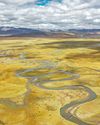
You have heard of Alexander the Great and Hannibal, but it's likely that the greatest general and military strategist of all has passed you by. He led the largest and most devastating horse-borne force ever seen, and conquered territories stretching from Hungary and Syria in the West, to Vladivostok and the Sea of Japan in the East. He pioneered siege engines and battlefield explosives, and devised new longbow designs. He laid the groundwork for modern warfare, from the Blitzkrieg strategy of the Nazis, to the use of chemical weapons and improvised explosive devices (IEDs). His name was Subotai the Valiant, and whilst Genghis Khan gained credit for the achievements of the Mongol Horde, it was Subotai who was the brains of the outfit.
Subotai was born near Lake Baikal, Siberia in 1175. As a child, his brother, Jelme, was pledged into the service of the Borjigin, the clan of Genghis Khan. He worked his way up to become a valued advisor, and when Subotai came of age and decided to turn his back on the family business of blacksmithing, it was Jelme who introduced him at court.
Jelme and Subotai were outsiders: Not only were they not Borjigin, they were not even Mongols. They weren't nomads, and they couldn't even ride. But Jelme's personal relationship with Genghis stood the brothers in good stead, and young Subotai was allowed to stand guard at the entrance to Genghis' tent, listening in to every conversation. As a result, he learned everything there was to know about Mongol military tactics: what had worked, and what had failed.
The Borjigin were just one of a large number of clans roaming the Mongolian steppe. Genghis Khan - the Great Khan - had yet to earn that moniker. The clans were constantly warring: They fought to control the best pastures, and possess the best horses, and blood feuds were rife. These small-scale conflicts gave young men like Subotai the chance to prove themselves.
Denne historien er fra AG 157-utgaven av ASIAN Geographic.
Start din 7-dagers gratis prøveperiode på Magzter GOLD for å få tilgang til tusenvis av utvalgte premiumhistorier og 9000+ magasiner og aviser.
Allerede abonnent ? Logg på
Denne historien er fra AG 157-utgaven av ASIAN Geographic.
Start din 7-dagers gratis prøveperiode på Magzter GOLD for å få tilgang til tusenvis av utvalgte premiumhistorier og 9000+ magasiner og aviser.
Allerede abonnent? Logg på

A Spectrum Of Scarlet: The Symbolic Red Of Asian Flags
A common thread that unites many Asian flags is the prominent use of red, a colour rich with symbolism

Curry: A World of Flavour, Tradition, and Culture
From its humble beginnings in India, the concept of "curry" has evolved into a culinary language understood around the world

The Power Of Asian Red Fruits - Discover 10 Nutrient-Rich Gems Of The East
In the vast tapestry of Nature, Asia has gifted the world an array of unique and vibrant fruits, particularly those in shades of red. These scarlet-hued gems, packed with flavour and nutrients, not only add a burst of colour to your plate but also carry valuable health benefits. From antioxidant-rich goji berries to the exotic dragon fruit, let's explore some of the most popular red fruits from Asia and discover why they should be part of your diet.

Bhutan: A World Of Its Own
With its majestic monasteries, red-robed monks, charming rural villages, and vibrant festivals, the Kingdom of Bhutan is a Himalayan paradise that promises an enriching travel experience like no other

Take The Red Pill
From the vermilion torii gates of Japan to the famed rust-hued walls of India's Agra Fort, the burgundy robes of Burmese monks to scarlet chillies drying in the Bangladeshi sun, red is the quintessential colour of Asia.

70 Days for Our Land Animals
Raising awareness about conservation, the environment, and the land-dwelling species of the world

The Red Panda
Meet the elusive guardian of the Eastern Himalayas

Revealed Doctor Yellow
Japan Railways' special lemony Shinkansen is a rare sight to behold

The Mighty Yellow
Over 5,000 kilometres long and flowing through nine provinces and autonomous regions, the Yellow River is China's second largest, after the Yangtze, while its basin is deemed the cradle of Chinese civilisation

Wildlife Big Yellow Beauty
The popular "amelanistic" form of the Burmese python is considered among the most beautiful snakes - if that's your sort of thing